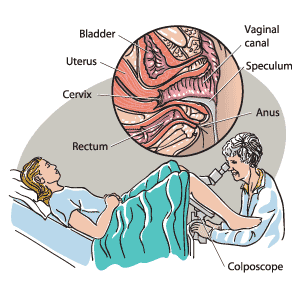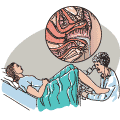Description of the test
A colposcopy uses a special microscope called a colposcope to closely examine the cells of the cervix, vagina, or vaginal opening for abnormalities. The colposcope allows the doctor to view the cells of the cervix at a size much bigger than normal. Abnormal cells are often removed (this procedure is called a biopsy) and are sent for further testing.
How often should the test be performed?
Doctors recommend this procedure as required to get a clearer look at the vagina, cervix, or surrounding tissues.
Why is this test performed?
A colposcopy is usually done if your Pap test results are abnormal. The purpose is to closely examine the cervix, vagina, and surrounding tissues to detect abnormal cells called precancerous cells.
Precancerous cells may turn into cancer cells. If these cells are found, samples may be taken for testing. Detecting precancerous cells or other abnormal tissue allows doctors to provide early treatment. Left untreated, precancerous cells may develop into cervical cancer.
By treating the problem early, a woman has a greater chance of preventing a serious health problem.
Are there any risks and precautions?
Although a colposcopy is generally considered safe, it does have some risk of side effects or complications. These include:
- abdominal pain
- heavy bleeding
- infection
If you experience these side effects or complications, contact your doctor immediately.
If you are concerned about any symptoms following this procedure, speak to your doctor. Take the time to be sure you understand all the risks of complications and side effects as well as any precautions you or your doctor can take to avoid them. Be sure your doctor understands all your concerns.
What happens during the test?
First, you remove some or all of your clothes and put on a gown. The doctor (or health care professional) asks you to lie on an examination table with your feet in stirrups.
Next, a speculum (a sterile instrument that helps keep the vagina open) is inserted into the vagina to allow a better view of the cervix. The doctor or health care professional then positions the colposcope at the opening of the vagina. The colposcope does not enter the vagina during the procedure.
To identify abnormal cells, the cervix is cleaned and a solution is applied that helps distinguish between normal and abnormal cells.
Taking a sample of abnormal tissue is common. A topical anesthetic (an anesthetic applied to the surface) may be applied to numb the area. Then, a small instrument is used to remove the cells. You may feel a pinch while the sample is collected. Bleeding can be controlled by applying a substance containing silver or iron to the area.
Colposcopy and biopsy are usually completed within 30 minutes.
How should I prepare for this test?
Before having this procedure, discuss the advantages, disadvantages, long-term risks, and consequences associated with the procedure with your doctor. Be sure you fully understand what will happen and are comfortable with your doctor's answers to your questions.
Your doctor may suggest that you empty your bladder and bowels before the procedure. This may make you feel more comfortable. Your doctor may also recommend that you take a pain reliever before your appointment.
Other preparations include:
- scheduling the procedure for a day when you do not have your menstrual period
- telling your doctor if you are pregnant or if you think you are pregnant
- avoiding sexual intercourse for 24 hours before the procedure
- not using any medications or products that are inserted into the vagina for 24 hours before the procedure (e.g., douches, yeast infection medications, tampons)
Tell your doctor or prescriber about all prescription, over-the-counter (non-prescription), and herbal medications that you are taking. Also tell them about any medication allergies and medical conditions that you may have.
Ask your doctor or pharmacist whether you need to stop taking any of your medications before the procedure.
What can I expect after the test?
You should have little or no discomfort after the procedure. You will have to wear a sanitary pad, not a tampon, if you experience any bleeding. Some bleeding for about 2 days after the procedure is normal. If a substance was applied to the vagina to control bleeding, you may notice some black discharge from the vagina.
Follow your doctor's instructions after the procedure. Most doctors recommend waiting for one week before having sexual intercourse and not inserting anything into the vagina for the same amount of time (e.g., tampons, medications). Check with your doctor before you leave.
If you experience a fever, prolonged bleeding, severe abdominal pain, or a foul-smelling discharge, you may have an infection that requires immediate medical attention, so see your doctor.
Results
Your doctor will review your results and discuss them with you at a follow-up appointment. Find out when to expect your results and be sure to contact your doctor if you do not hear from your doctor's office within the expected time.
All material copyright MediResource Inc. 1996 – 2024. Terms and conditions of use. The contents herein are for informational purposes only. Always seek the advice of your physician or other qualified health provider with any questions you may have regarding a medical condition. Source: www.medbroadcast.com/procedure/getprocedure/Colposcopy


